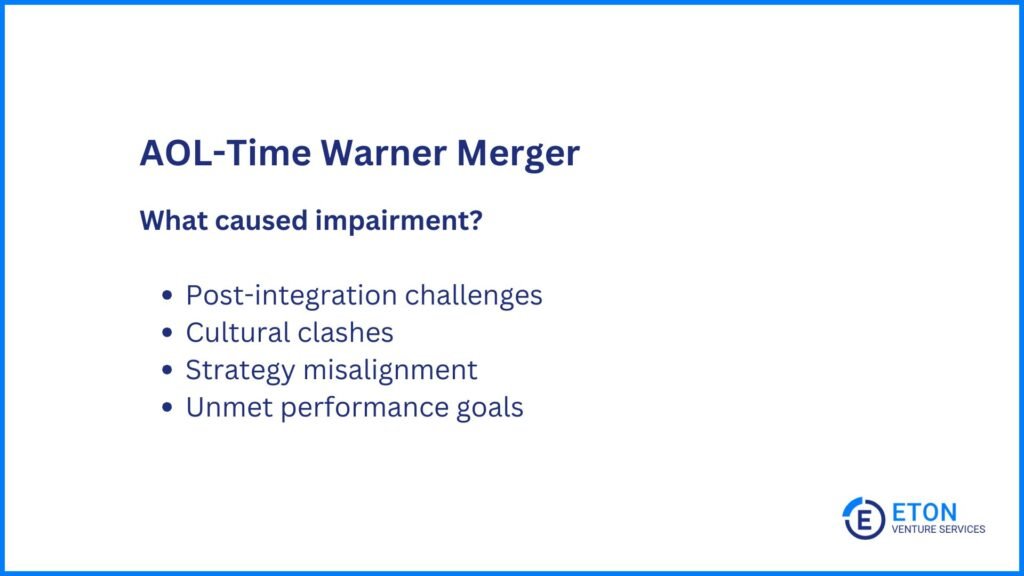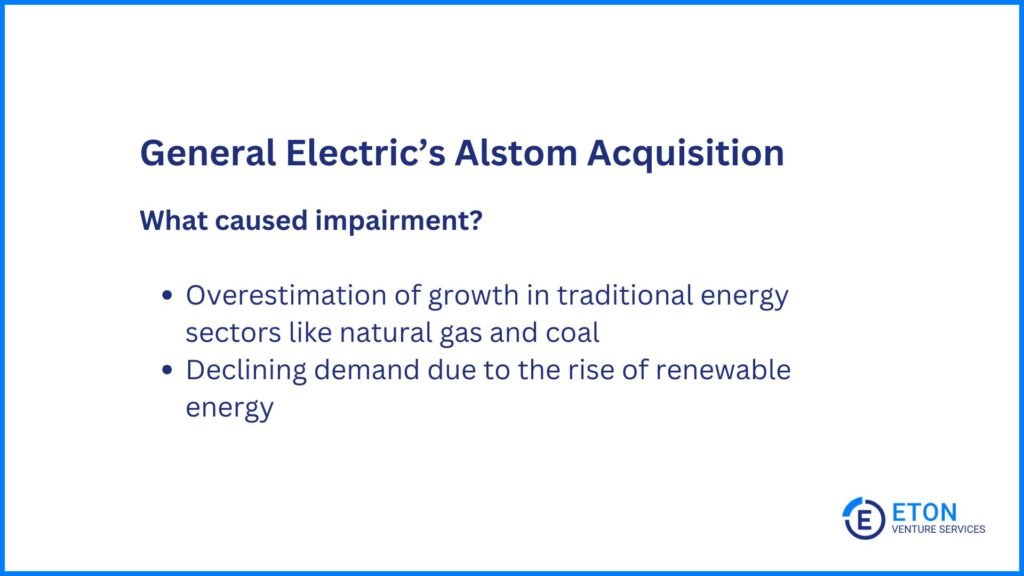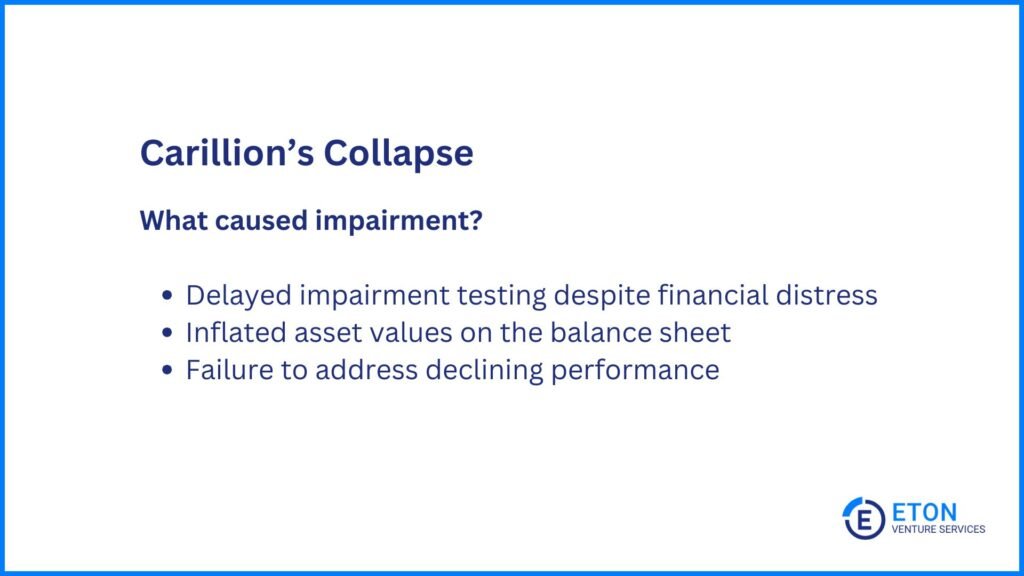Hi, I’m Chris Walton, author of this guide and CEO of Eton Venture Services.
I’ve spent much of my career working as a corporate transactional lawyer at Gunderson Dettmer, becoming an expert in tax law & venture financing. Since starting Eton, I’ve completed thousands of business valuations for companies of all sizes.

Read my full bio here.
In 2002, the AOL-Time Warner merger resulted in the largest goodwill impairment ever recorded, with a staggering $54 billion write-down.
What was supposed to be a groundbreaking acquisition quickly turned into a cautionary tale, as strategic misalignment and cultural clashes caused the combined company’s value to plummet.
This serves as a powerful reminder: failing to test and report on goodwill impairment can have devastating financial consequences.
Misleading financial statements, weakened investor confidence, and significant losses can follow if companies don’t proactively manage their goodwill.
For any company carrying goodwill on its balance sheet, impairment testing isn’t just about compliance – it’s essential for safeguarding financial integrity.
In this article, we’ll look at 8 real-world examples of goodwill impairment to help you understand the special cases to watch out for and the impact of them.
Key Takeaways
|
|
Need a reliable goodwill valuations & testing partner? Click here to learn about our goodwill impairment services. |

Goodwill impairment happens when the value of goodwill on a company’s balance sheet is higher than its fair market value.
This means the goodwill accrued during a company acquisition – like brand value or customer loyalty – has dropped below the originally recorded amount due to internal or external factors.
In such cases, companies must test for impairment and revalue goodwill promptly to maintain transparency and avoid larger write-downs in the future.
Both U.S. GAAP (Generally Accepted Accounting Principles) and IFRS (International Financial Reporting Standards) require annual goodwill impairment testing and additional tests whenever a “triggering event” occurs.
These events – such as a sharp drop in revenue, a decline in share price, leadership changes, or market shifts – can signal that goodwill no longer reflects its true value. We’ll cover the most prominent triggering events later in the article.
When impairment is identified, companies must disclose key details, including what triggered it, the affected units, and how fair value was calculated.
This transparency ensures that investors and stakeholders understand the company’s financial position and the reasons behind the write-down.
Understanding the mechanisms of goodwill impairment is important, but seeing how these processes play out in real companies can provide deeper insights.
The following case studies show how major businesses dealt with goodwill impairments and the lessons we can take from their experiences:

In 2000, AOL, a major internet service provider, and Time Warner, a leading media conglomerate, merged in what was seen as a groundbreaking deal at the time.
However, the merger quickly ran into significant post-integration challenges. Cultural clashes between the two companies, along with misaligned strategies and unmet performance goals, led to a dramatic decline in market value.
By 2002, AOL-Time Warner was forced to record a $54 billion goodwill impairment – the largest in history at that time. This demonstrates how poor integration and strategic misalignment after mergers can severely damage company value and lead to significant write-downs.

In 2014, Microsoft acquired Nokia’s smartphone division for $7.9 billion, aiming to expand into the mobile market. However, intense competition from Apple and Android devices, along with low consumer interest in Microsoft’s Windows Phone, quickly hindered this strategy.
By 2015, just a year after the acquisition, Microsoft took a $7.6 billion goodwill impairment, nearly the entire purchase amount.
This impairment reflected the sharp decline in Nokia’s value as Microsoft struggled to keep up with rapid technological shifts and changing consumer preferences. It’s a reminder of how quickly tech trends can change and the risks they pose to acquisitions.

Increased competition can erode a company’s market position and reduce the expected benefits of acquisitions.
For example, in 2015, AT&T acquired DirecTV for $49 billion, intending to strengthen its pay-TV offering and expand its customer base.
However, the rapid rise of streaming services like Netflix and Hulu transformed the entertainment industry, drawing consumers away from traditional TV.
As consumer preferences shifted, DirecTV’s value declined, and by 2021, AT&T recorded a $15.5 billion goodwill impairment on the acquisition.
This is another example that illustrates how increased competition and evolving market trends can significantly impact the long-term value of acquisitions.

In 2018, General Electric (GE) recorded a $22 billion goodwill impairment, largely tied to its 2015 acquisition of Alstom’s power business.
GE had expected significant growth in traditional power generation, particularly in natural gas and coal. However, market conditions shifted as renewable energy sources gained momentum, and demand for traditional energy declined.
This misjudgment led to a sharp drop in expected cash flows. The goodwill impairment also triggered investigations by the Securities and Exchange Commission (SEC) and the Department of Justice into GE’s accounting practices.
Following the write-down, GE’s power division had no remaining goodwill, reflecting the significant financial impact of its acquisition miscalculation.
This case highlights the risks of overpaying for acquisitions without considering how market trends might change.

Carillion, a major UK construction firm, delayed necessary impairment testing despite clear signs of financial distress.
By failing to respond to declining performance and financial instability, Carillion’s balance sheet showed inflated asset values. This contributed to the company’s eventual collapse in 2018, when it could no longer sustain its operations.
Carillion’s story underscores the importance of timely goodwill impairment testing, especially when financial struggles are evident.

Walgreens recorded a $5.8 billion goodwill impairment due to its investment in VillageMD, a healthcare company.
Despite VillageMD’s poor performance and declining market value, Walgreens did not address these issues promptly.
Eventually, the gap between the recorded value of VillageMD and its actual market conditions became too large to ignore, forcing Walgreens to write down the value of its investment.
This case highlights the dangers of delaying action when business performance declines, as it can lead to substantial impairments.

In 2011, HP acquired the British software company Autonomy, only to later discover accounting irregularities within the company. These issues could have been identified earlier with better due diligence, but HP missed the warning signs.
The acquisition resulted in an $8.8 billion goodwill write-down for HP, driven by poor documentation and oversight during the acquisition process.
This highlights the importance of thorough due diligence when acquiring new businesses to avoid costly mistakes.

In 2019, Kraft Heinz recorded a $15.4 billion goodwill impairment due to the declining value of its Kraft and Oscar Mayer brands, which were part of the company’s 2015 merger with H.J. Heinz.
The company’s aggressive cost-cutting measures under 3G Capital reduced spending on research, development, and quality control, weakening brand strength and customer relationships. This forced Kraft Heinz to reassess the value of its acquired brands.
The impairment highlights how neglecting investment in brand quality and long-term sustainability can lead to significant losses in brand value.
As you may have noticed, the one thing these examples have in common is how failing to act on early warning signs led to significant goodwill impairments.
This underscores that closely monitoring and promptly addressing triggering events is necessary to protect a company’s financial health. Here are some key triggers to watch out for:
|
Internal triggers |
External triggers |
|
Annual testing: Goodwill needs to be tested at least once a year according to U.S. GAAP and IFRS rules. |
Economic downturns: Recessions or rising inflation can hurt business performance and may lead to a goodwill review. |
|
Loss of key customers: Losing important clients can reduce expected revenue and trigger a review of goodwill. |
Industry disruptions: Changes like new technology, regulations, or increased competition can impact revenue and may require goodwill testing. |
|
Underperformance: If a business or acquisition isn’t meeting profit or revenue goals, goodwill may need to be adjusted. |
Cost pressures: Rising costs or supply chain problems could signal the need to reassess goodwill. |
|
Restructuring or leadership changes: Major shifts in the company or management may lead to a review of goodwill. |
Drop in market value: A significant decrease in stock price or market value may point to lower future profits, requiring a goodwill test. |
|
Operational issues: Challenges like production delays or declining sales can signal a need for goodwill impairment testing. |
Legal or regulatory problems: Legal issues or regulatory changes can prompt a review of goodwill, especially in regulated industries. |
If you want to learn about goodwill impairment triggering events in more detail, read this guide.
Once a company records goodwill impairment, it sets off a series of financial and operational consequences. Here’s what typically happens after a goodwill impairment is recognized:
As we’ve seen from the examples above, goodwill impairment can have serious financial consequences. While it’s sometimes unavoidable, there are steps businesses can take to minimize the risk and protect their investment.
Here are key strategies you can implement to reduce the likelihood of significant write-downs:
By incorporating these strategies into your acquisition and management processes, you can avoid unexpected goodwill write-downs and confidently handle goodwill impairment.
The examples throughout this article highlight how overlooking goodwill impairment can lead to substantial financial damage.
However, it’s not enough to simply recognize the risks – what’s more important is taking action to address them. This is where regular goodwill impairment testing comes in.
Testing is the necessary next step to ensure that any changes in the value of goodwill are caught and reflected accurately on financial statements. It’s not just about compliance; it’s about protecting the financial integrity of the business.
This is where working with valuation firms like Eton is of great help. Our financial experts assist not only with the testing itself but also in identifying triggers, performing accurate valuations, and ensuring your business complies with U.S. GAAP and IFRS.
In short, by partnering with us, you can stay ahead of potential issues and make sure goodwill is properly assessed and recorded to protect your company’s financial stability in the long run.
Goodwill impairment is typically a negative indicator, as it suggests a decline in the value of acquired assets. Significant impairments can point to poor acquisition decisions, financial challenges, or unfavorable market conditions, potentially impacting investor confidence and reducing a company’s valuation.
Goodwill impairment is calculated by comparing the carrying value of goodwill with its fair value. If the fair value is lower, the difference is recorded as an impairment loss on the company’s financial statements. Understanding the value of your goodwill requires a third-party goodwill valuation company.
Goodwill impairment reduces the carrying value of goodwill on the balance sheet and is recorded as an expense on the income statement. This decreases net income and potentially lowers key financial metrics like earnings per share (EPS) and return on assets (ROA).
Companies must disclose goodwill impairments in financial reports, detailing the triggering events, affected units, and methods used to calculate fair value. This transparency helps investors understand the reasons behind the impairment and its impact on the company’s financial health.
Schedule a free consultation meeting to discuss your valuation needs.
Chris Walton, JD, is is President and CEO and co-founded Eton Venture Services in 2010 to provide mission-critical valuations to private companies. He leads a team that collaborates closely with each client’s leadership, board of directors, internal / external counsel, and independent auditors to develop detailed financial models and create accurate, audit-ready valuations.